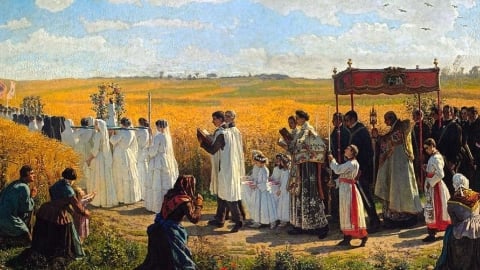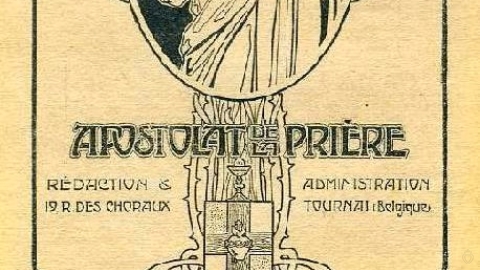Practice of Perfection and Christian Virtues

At what period of his life did Father Rodriguez write his Practice of Perfection and Christian Virtues? The bulk of it was written and delivered as exhortations during the thirteen years he was master of novices at Montilla. At the bidding of superiors, he arranged the material and improved it during his stay at Cordova, and finally published the first edition in 1609 and the second in 1611 at Seville. During the last year of his life, though suffering greatly from his infirmities, he revised the whole work for a third edition. When he was informed on the Feast of the Purification, 1616, that the printing of it was completed, he folded his hands and said cheerfully, “Now thou dost dismiss thy servant, O Lord, according to thy word in peace” (Luke 2:29). Two weeks later he was dead.
The book has gone through more than fifty editions in Spanish, and has been translated into at least twenty languages, including Arabian, Tamil, and Chinese. Among the French translations we find one made by the Jansenists in 1673, in which they secretly inserted their erroneous doctrines on grace.
The first English version was published between 1697 and 1699, the translator being none other than Sir John Warner, Baronet, of Parham in Suffolk, otherwise known as Father John Clare, S.J. He is an interesting personage. With his young wife he was converted to the true faith and both decided to become religious. She became Sister Clare of the Poor Clares of Gravelines; he became a Jesuit. They made their solemn profession on the same day, August 15, 1667: Subsequently he became procurator and later provincial of the English Province, but spent most of his life as master of novices and spiritual father at the English novitiate at Watten, Belgium. It was there towards the end of his life that he made his translation through the medium of the French version of Abbé Regnier des Marais, and saw it through the nearby press of St. Omers. Father Joseph Rickaby, S.J., the most recent English translator, made some use of it, for he notes in his preface: “It has cost the present translator a world of toil and trouble. In my veneration for the quaint old seventeenth century version, still read amongst us, I endeavored to base my work upon that, instead of doing what I was ultimately forced to do, translating straight from the Spanish.”
Practice of Perfection and Christian Virtues is primarily and almost exclusively an ascetical, not a mystical,. work. To criticize it unfavorably, as some have done in recent years, for not discussing mystical prayer at length is unfair. Such was not the purpose of the book. Its author's principal aim was the training of young religious; accordingly, being a man of prudence and common sense, and a good pedagogue, too, Rodriguez adapted his teaching on higher prayer to the limited capacity of his disciples, who were mostly beginners in the spiritual life. He is not “anti-mystical.”
The work deals not so much with the theory of asceticism as with its practice. The author says that he put the word Practice in the title because “things are treated in it in such a way as may render their practice very easy.” Nor is the subject-matter discussed comprehensively in all its details: “I have laid before you, as clearly and briefly as I was able, such things as are more essential and more common to our profession.” However, this practical, limited scope does not on that account place his spirituality on a low plane. Rodriguez seeks to lead religious to the highest sanctity by faithfulness to duty in little things, by perfect performance of ordinary actions, by unremitting purity of intention, by habitual and ever closer conformity to the will of God. He endeavors to form religious of sustained prayer, mortification, apostolic zeal, and all the virtues; and he points to the loftiest exemplars, Christ and His saints, for “to attain to perfection, one must fix his eyes on what is highest and most excellent.” And who will say that he has not succeeded?
The principal sources of Rodriguez' doctrine are Holy Scripture, the Fathers of the Church, and the great spiritual masters of the past, with a particular predilection for those stalwarts, the religious of the desert. Among the most frequently cited authorities are Saint Augustine (271 times), Saint Bernard (258 times), Saint Thomas Aquinas (86 times), and Cassian.
His composition is clear and methodical; his language is pure Castilian and above the ordinary in literary merit, though somewhat prolix. He has imagination and a kindly humor-“pepper and salt,” as one writer says. For example, he says that a religious who jumps hastily and lightly from virtue to virtue is “like a cat walking on hot coals.” In addition, all will agree that Rodriguez has an indefinable unction all his own.
Of course, Alphonsus Rodriguez is by no means the perfect author. In his knowledge of things scientific, historical, and hagiographical, he is a man of his times. He considers certain apocryphal works authentic; too often he copies his sources at second hand; he draws considerably on the unpublished exhortations of his Provincial, Father González Dávila, without giving him due credit. A few points of his doctrine can be legitimately contested and even. impugned. Some of his examples and anecdotes are considered today to be lacking in good taste: many of these have been excised in recent editions. But, after all, these are only minor flaws in an author whose work is a masterpiece of spiritual writing that has successfully stood the test of time, and that even with readers who are more than ordinarily critical and exacting. It is today the most widely used spiritual textbook of religious the world over. A definitive critical edition would indeed be very welcome.
Many witnesses could be cited to prove the value and popularity of Rodriguez. For example, Father Faber calls the book “an inestimable treasure of the Church.” Founders and foundresses of religious congregations have been especially lavish in their praises. Our own Mother Cabrini drew up a list of five books as constituting a sufficient spiritual library for her congregation. They are: the Imitation of Christ, the Spiritual Exercises, the Religious in Solitude of Father Pinamónti, S.J., the Bride of Christ of Saint Alphonsus Liguori, and the Practice of Alphonsus Rodriguez. Saint Alphonsus Liguori and Saint John Eudes often recommended the Practice. Let Saint Vincent de Paul, the founder of the Lazarists, be our last witness. In an instruction to his religious congregation dated May 17, 1658, accompanying the book of Rules he was sending, he exclaims: “O Lord, who hast bestowed such blessings on many books, for example, on the one we are now reading at table, so that well-prepared souls might reap therefrom considerable fruit, in order to free themselves from their faults and go forward in perfection, grant, O Lord, thy blessing on this our little book ...” Father Pierre Coste, the saint's official biographer, says that the book being read at table was none other than the Practice of Perfection and Christian Virtues by Alphonsus Rodriguez.





